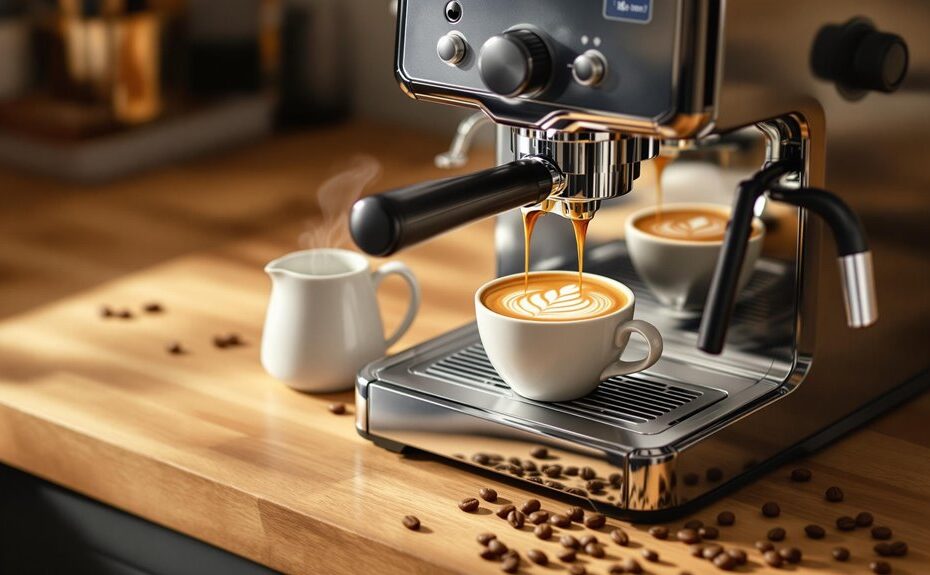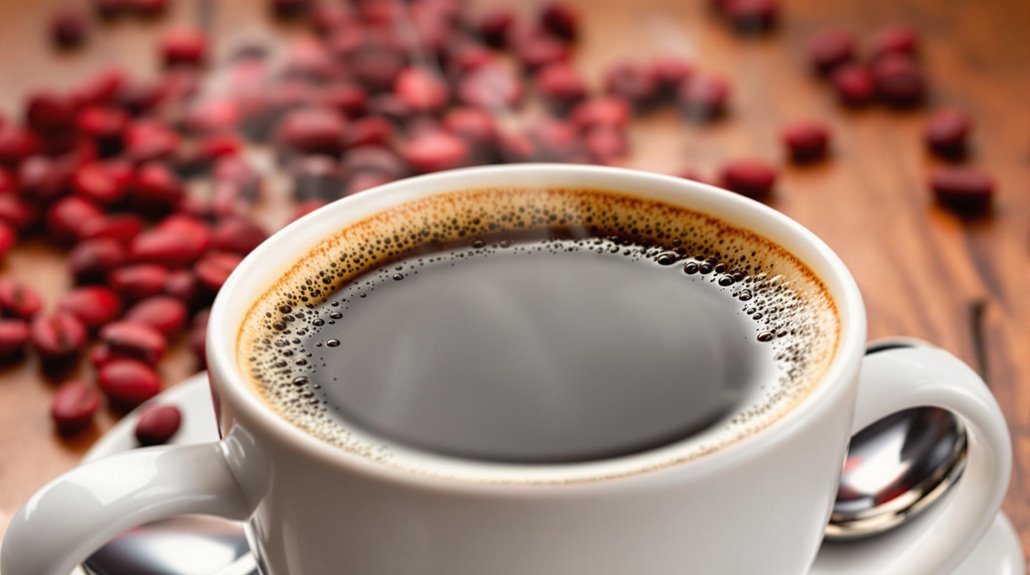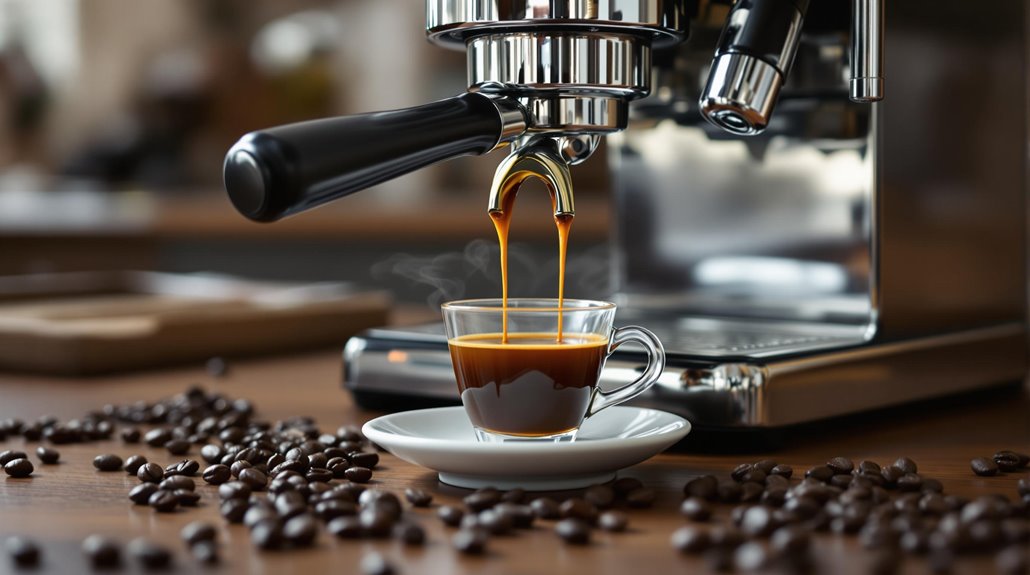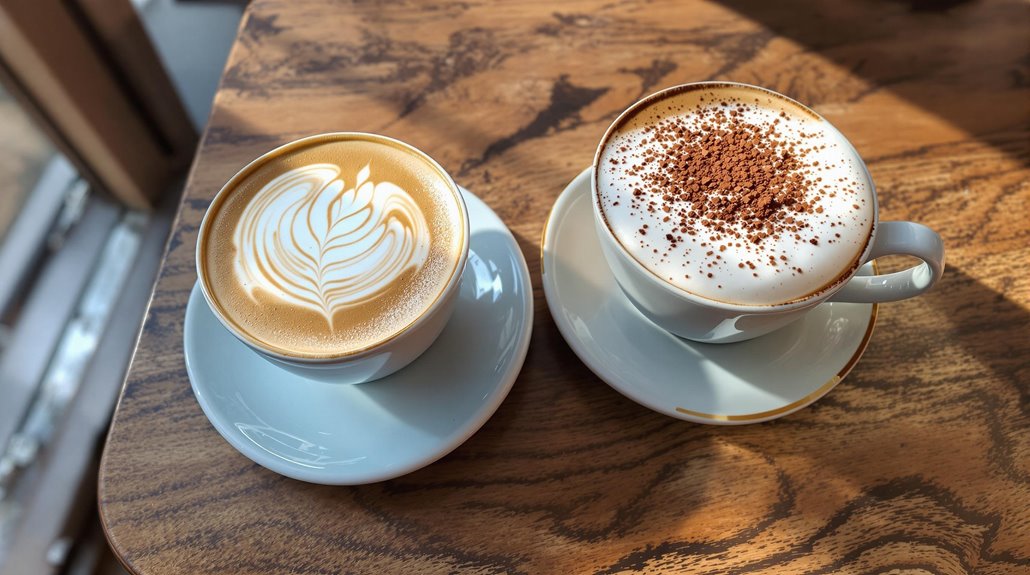







Making espresso at home can seem intimidating, but it doesn't have to be. You'll need to pay attention to a few key elements, like selecting the right coffee beans and mastering your brewing technique. With the right equipment and a little practice, you can enjoy café-quality espresso in the comfort of your kitchen. But before you rush off to gather supplies, let's explore the essential steps that can transform your morning routine. What's the first thing you should consider?
Key Takeaways
- Use a quality espresso machine that can generate ~9 bars of pressure for optimal extraction of flavors.
- Grind fresh coffee beans to a fine consistency, aiming for 18-20 grams for a double shot.
- Ensure the water temperature is between 190°F and 205°F for ideal brewing conditions.
- Tamp the coffee grounds evenly in the portafilter to promote uniform extraction during brewing.
- Clean your equipment regularly and use freshly roasted beans within 2-3 weeks for the best flavor.
Understanding Espresso
Espresso is more than just a shot of coffee; it's a complex brewing method that delivers a concentrated burst of flavor in every sip. To achieve this, you force hot water through finely-ground coffee under approximately 9 bars of pressure. This process extracts essential oils and flavors, resulting in a rich, creamy consistency known as crema.
When crafting your perfect espresso, the choice of beans matters immensely. Medium to dark roast coffee is preferred for its robust flavor, and freshness is critical—ideally, use your coffee within 2-3 weeks of roasting. The grind size plays a pivotal role as well; you want a fine consistency that's finer than table salt but not powdered. This guarantees ideal extraction, allowing the full range of flavors to shine through.
Finally, your espresso machine is the heart of this brewing process. Whether you opt for a manual, semi-automatic, or automatic machine, the method you choose can influence the consistency and quality of your espresso. With the right knowledge about brewing, water, and beans, you're well on your way to mastering this delightful coffee experience.
Essential Equipment
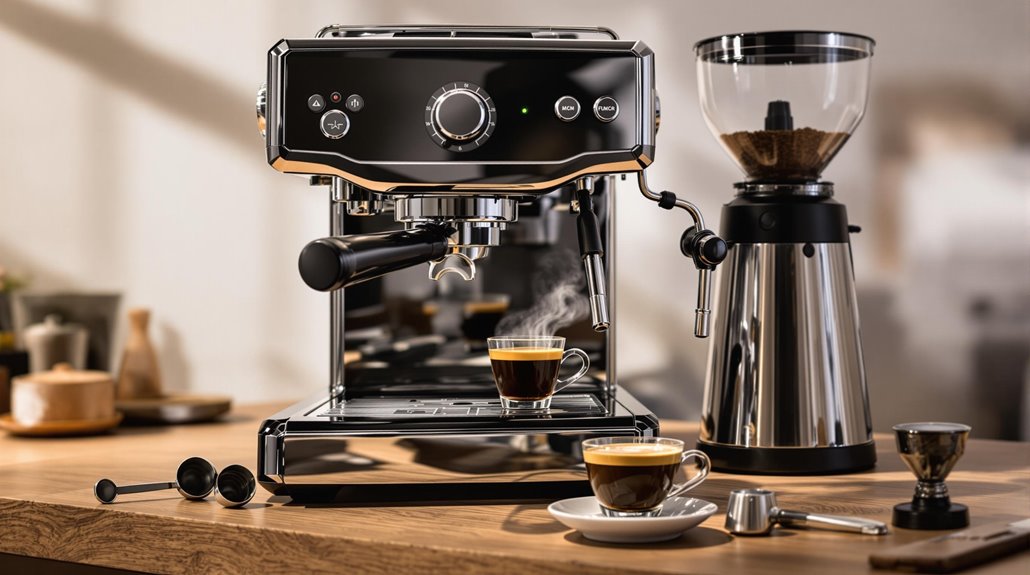
To craft the perfect espresso at home, you need the right tools in your arsenal. A quality espresso machine, a reliable burr grinder, and a precise kitchen scale are your essentials, ensuring you achieve the ideal pressure and grind. Don't overlook water quality; it plays a vital role in extracting the rich flavors you're aiming for.
Required Brewing Tools
Creating a rich, flavorful espresso at home hinges on having the right tools at your disposal. First and foremost, invest in a quality espresso machine that can generate the necessary pressure—around 9 bars—is fundamental for ideal extraction. You'll find options ranging from manual to automatic machines, each suited to different skill levels.
Next, a burr grinder is important for achieving a consistent fine grind. The grind size greatly influences the extraction and flavor profile of your espresso. A kitchen scale is also recommended for measuring your coffee grounds accurately; aim for a dose of 18 to 20 grams for a double shot to guarantee precise brewing.
Don't forget a tamper, which is essential for compressing the coffee grounds evenly in the portafilter. This step assures uniform extraction during the brewing process. If you plan to whip up espresso-based drinks like lattes or cappuccinos, a milk frother or steam wand is a must-have. It allows you to create that luscious, textured milk that elevates your espresso experience to new heights. With these important tools in hand, you're well on your way to mastering the art of brewing espresso at home.
Grinder and Water Quality
Achieving the perfect espresso starts with the right grinder and water quality. A quality burr grinder is essential for producing a consistent fine grind, which should be finer than table salt but not powdered. This precision allows for ideal flavor extraction from your freshly roasted coffee beans, which you should ideally use within 2-3 weeks of roasting.
Next, don't underestimate the importance of water. Using filtered water is critical, as impurities in tap water can introduce off-flavors that ruin your brew. Aim for a water temperature between 190°F and 205°F during brewing; this range helps extract the rich flavors without scorching your coffee.
Lastly, regular maintenance of your grinder and espresso machine is fundamental. Clean them frequently to prevent residue buildup, which can alter the flavor of your espresso. By prioritizing the quality of your grinder and water, you'll be well on your way to crafting exceptional espresso at home. Remember, every detail counts in this artisanal process, and your commitment to quality will shine through in every cup.
Coffee Selection
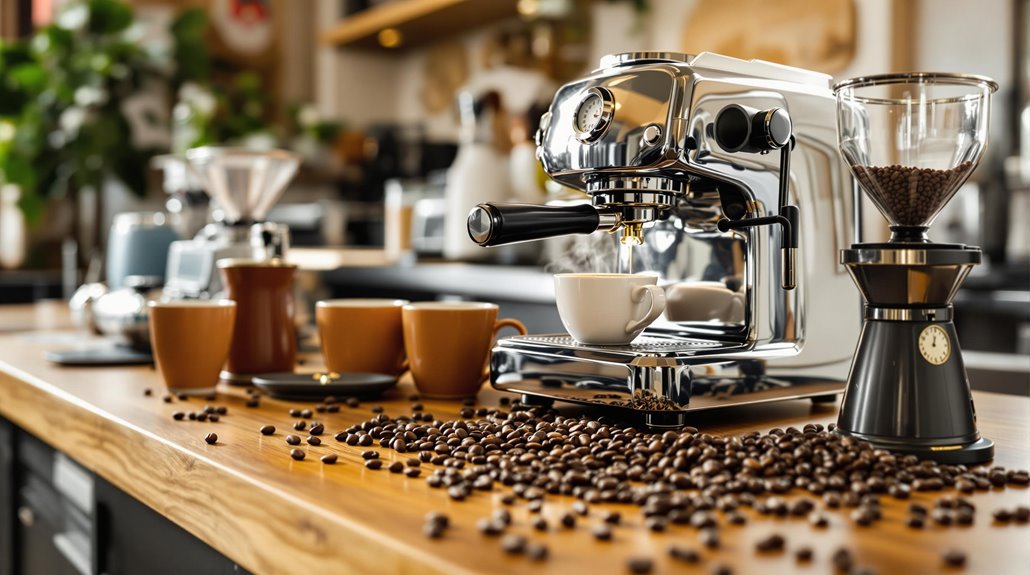
When selecting coffee for your espresso, it's essential to focus on medium to dark roast varieties that deliver rich, robust flavors. Specialty grade beans are your best bet, as they enhance the overall profile of your brew. Aim for freshly roasted coffee, ideally used within 2-3 weeks of roasting, to guarantee peak taste and aroma.
You'll want to choose between Arabica or Robusta beans. While there aren't specific "espresso beans," blends tailored for espresso often excel in flavor depth. If you're adventurous, consider single origin beans; they bring unique taste characteristics and distinct flavor notes that can elevate your espresso experience.
Don't overlook the grind size. For the best extraction, your coffee should be finely ground—finer than table salt but not powdered. This precision is key, especially if you're using methods like AeroPress or Moka Pot. Remember, the right coffee selection sets the foundation for an exceptional espresso, so take your time exploring different beans and roasts. Experiment with various combinations until you find the perfect blend that resonates with your palate and enhances every sip of your espresso.
Brewing Techniques

When you're ready to brew espresso at home, mastering the techniques is key to achieving that rich, concentrated flavor. You'll explore various methods like the AeroPress, Moka pot, and even the French press, each offering a unique approach to crafting your perfect shot. Let's break down the steps to elevate your home brewing experience.
AeroPress Method Overview
The AeroPress is a versatile tool that elevates your home brewing experience, allowing you to craft espresso-like shots with ease. To make espresso without the need for an expensive machine, start by grinding 2 tablespoons (about 20-22 grams) of your favorite coffee beans to a fine consistency—think finer than table salt but not powdered.
Next, place a filter in the AeroPress cap, rinse it lightly, and add your ground coffee to the chamber. Heat 3 ½ oz of hot water to around 200°F and pour it over the coffee. Gently stir the mixture to verify all grounds are saturated before you begin the brewing process.
With consistent force, press down on the plunger for about 20-30 seconds. This brew method yields a concentrated shot that resembles perfect espresso, complete with rich flavor and crema. Feel free to experiment with different dark roast coffee beans, grind sizes, and water temperatures to customize your espresso-like coffee. The AeroPress allows for endless experimentation, making it an ideal choice for coffee enthusiasts looking to refine their brewing skills.
Moka Pot Brewing Steps
Making coffee with a Moka pot is a time-honored technique that delivers a rich, robust flavor reminiscent of traditional espresso. To start, fill the bottom chamber of your Moka pot with water up to the safety valve—don't overfill it! Next, add 20-22 grams of finely ground coffee into the filter basket, leveling it off gently without pressing down to prevent clogging.
Once you've added the coffee, securely screw the top and bottom chambers together, ensuring a tight seal to keep steam from escaping. Now, place the Moka pot on medium heat. As it warms up, keep an ear out for the bubbling sound indicating that your brew is on its way. This process usually takes about 5-10 minutes.
When the bubbling sound shifts to a hissing noise, it's time to remove the pot from the heat. Carefully pour the brewed coffee into a demitasse, and get ready to savor its unique flavor profile. Enjoy the aromatic experience that only a Moka pot can provide—your homemade espresso-like coffee awaits!
French Press Technique Guide
If you've enjoyed the rich flavor of coffee brewed with a Moka pot, it's time to explore another method that delivers bold and concentrated results: the French press. To make espresso at home without an espresso machine, start by blooming 2 tablespoons of finely ground coffee using a splash of boiling water. Let it sit for 30 seconds to enhance the flavor extraction. Then, add the remaining water heated to just below 200°F.
Next, steep the coffee for 4 minutes. This vital step allows the flavors to develop fully. After steeping, press down the plunger halfway, then fully to separate the grounds from the liquid. For a double shot of espresso-like strength, aim for a coffee-to-water ratio of 1:4 and use a slightly finer grind than typical for French press brewing.
Once pressed, pour the brewed coffee into a mug immediately to prevent over-extraction and bitterness. This technique yields great espresso-like coffee, perfect for those who appreciate a robust flavor. Enjoy your freshly brewed coffee using the French press, and savor the artisanal experience it offers!
Making Espresso Without a Machine
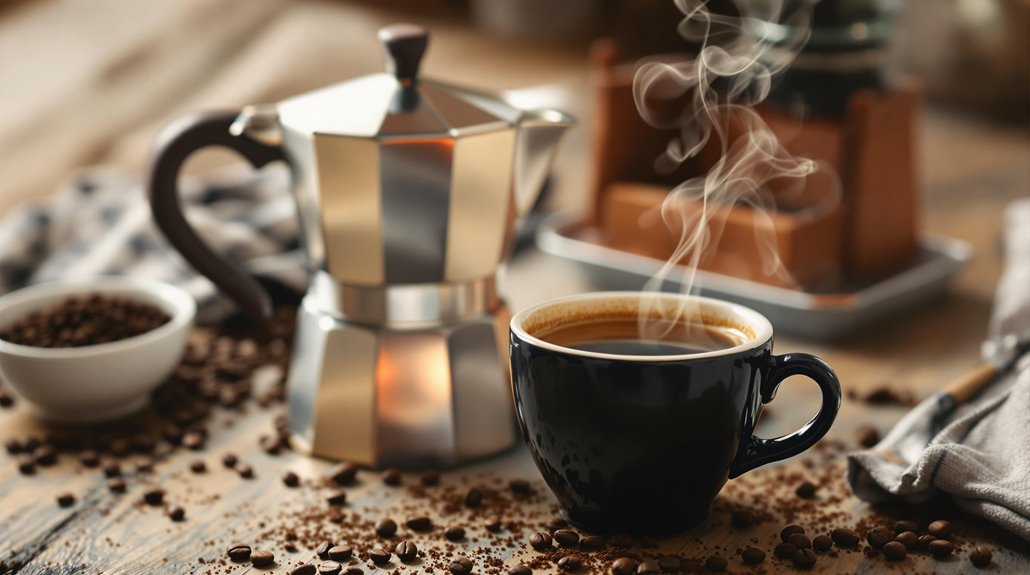
Crafting espresso at home without a machine can feel like an exciting challenge, and it's entirely possible with a few clever tools at your disposal. The AeroPress is a fantastic option; start by finely grinding 20-22 grams of medium roast coffee. Place it in the filter, pour 3 ½ oz of hot water at 200°F, stir, and then press down firmly for a concentrated brew that rivals traditional espresso.
Alternatively, the Moka Pot yields a rich espresso-like flavor. Fill the bottom chamber with water, add the finely ground coffee to the filter, and heat on medium until the top chamber fills with brewed coffee.
While the French Press isn't true espresso, it can produce a strong brew. Steep 2 tablespoons of finely ground coffee in 1 cup of nearly boiling water for 4 minutes, then press down the plunger.
Experimenting with grind size, coffee-to-water ratio, and steeping times can help you refine your espresso-like beverage. With these methods, you can enjoy the art of making espresso without a machine and impress your taste buds.
Frothing Milk
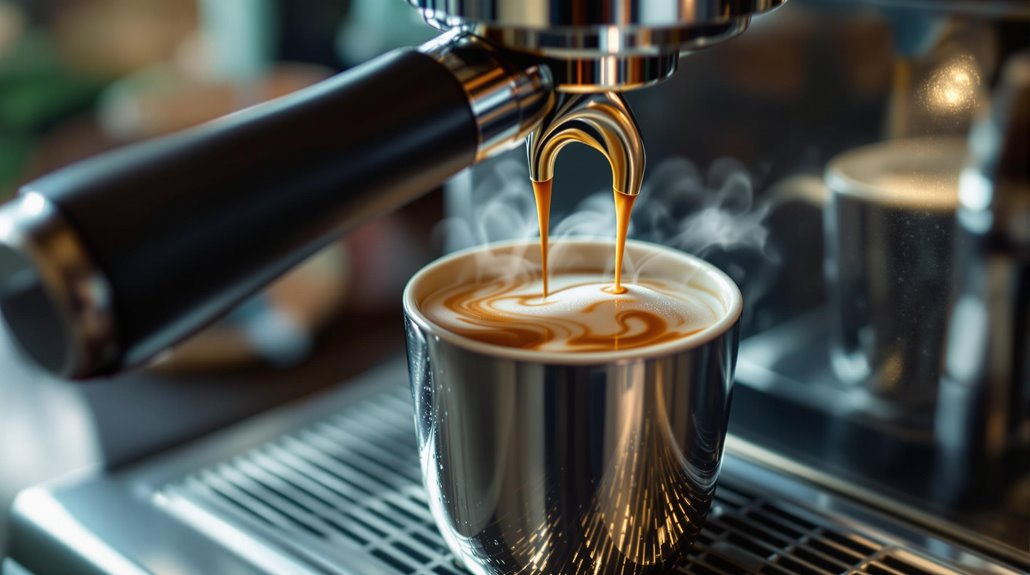
Frothing milk elevates your homemade espresso experience, transforming it into a café-quality beverage. To start, fill your pitcher to about a finger's width below the spout. Before you froth, purge the steam wand to eliminate any residual water. Position the steam wand at a slight angle just below the surface of the milk. This technique introduces air while steaming, which helps you achieve that sought-after creamy texture with fine bubbles.
As you steam, maintain a quiet hissing sound to guarantee ideal aeration. Overdoing it can lead to grainy foam, which you definitely want to avoid. For the best results, opt for whole milk or barista-friendly alternatives like oat or almond milk, as they froth better and yield a richer texture.
Serving Suggestions
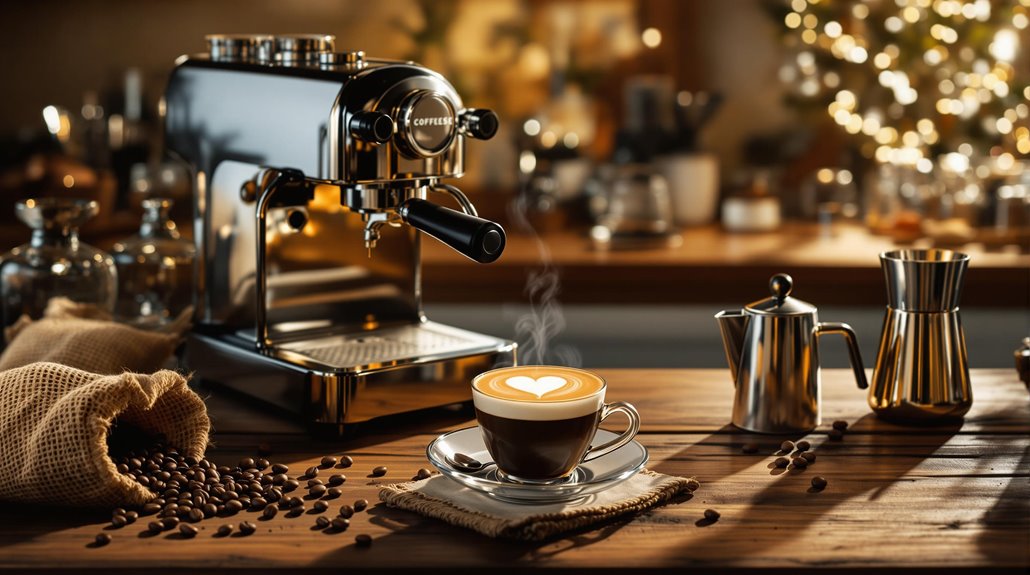
Once you've perfected your frothing technique, it's time to elevate the entire espresso experience. Start by serving your espresso shot in a small demitasse cup, which typically holds 1-2 ounces. This highlights the concentrated flavor of your brew, allowing you to savor every drop.
To enhance the tasting experience, consider pairing your espresso with traditional accompaniments like biscotti or dark chocolate. These treats add contrasting textures and complement the bold coffee. For a twist, experiment with flavorings such as vanilla, caramel, or hazelnut syrups—these can create unique variations that cater to your palate.
If you're in the mood for something different, try enjoying your espresso as an Americano. Just add a splash of hot water to your espresso shot; this reduces the intensity while still preserving its rich flavors.
Finally, serve a glass of sparkling water alongside your espresso. This not only cleanses your palate but also prepares you for the bold flavors of the coffee, enhancing your overall experience. With these serving suggestions, you'll transform a simple espresso into a delightful ritual.
Espresso Maintenance Tips
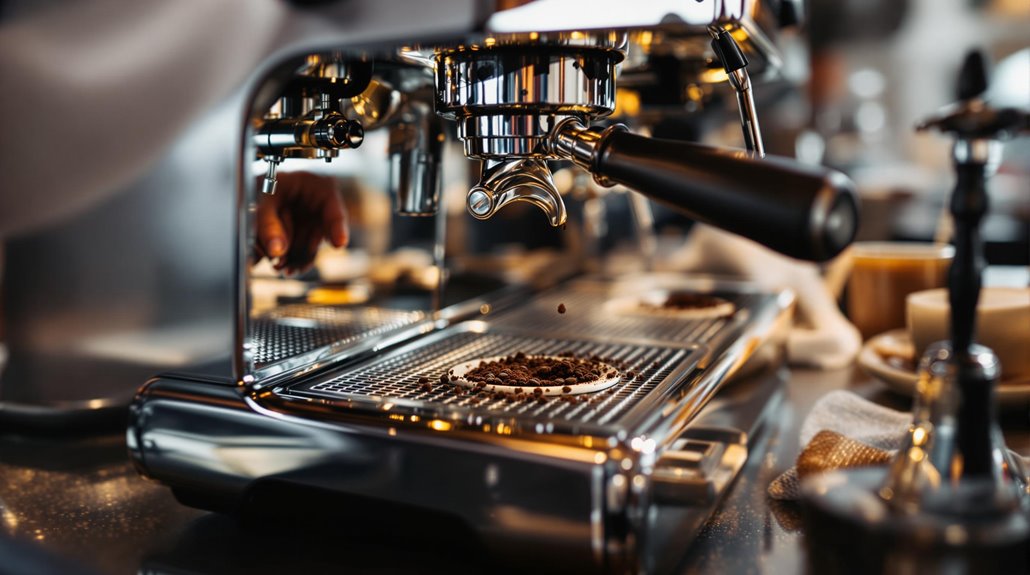
To keep your espresso machine performing at its best and guarantee every shot is packed with flavor, maintenance is key. Start with the basics: after each use, thoroughly clean and dry your portafilter, group head, and steam wand. This prevents coffee oil buildup, safeguarding optimal flavor with every extraction.
Next, don't overlook descaling your espresso machine every 1-3 months, depending on your water hardness. This process removes mineral deposits that can hinder performance and alter taste. Replacing your water filter every 2-3 months is also vital; it guarantees high-quality water for brewing, enhancing your espresso's overall profile.
Keep your grinder clean by regularly removing old coffee grounds and oils, and calibrate it to maintain a consistent grind size. A precise grind is necessary for ideal extraction, which directly impacts flavor.
Finally, store your coffee beans in an airtight container, away from light and moisture. Aim to use them within 2-3 weeks of roasting for the best flavor. By following these espresso maintenance tips, you'll enjoy a consistently delightful cup every time.
Disclosure: As an Amazon Associate, I earn from qualifying purchases.
